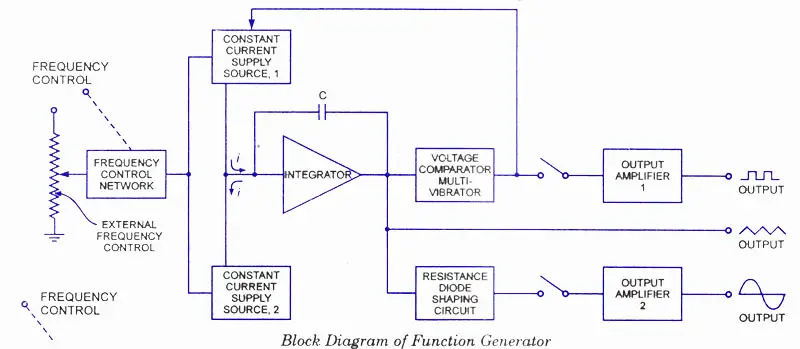All About Function Generators
A function generator is a signal source that has the capability of producing different types of waveforms as its output signal. The most common output waveforms are sine-waves, triangular waves, square waves, and sawtooth waves. The frequencies of such waveforms may be adjusted from a fraction of a hertz to several hundred kHz.
Actually, the function generators are very versatile instruments as they are capable of producing a wide variety of waveforms and frequencies. In fact, each of the waveforms they generate is particularly suitable for a different group of applications. The uses of sinusoidal outputs and square-wave outputs have already been described in the earlier Arts. The triangular-wave and sawtooth wave outputs of function generators are commonly used for those applications which need a signal that increases (or reduces) at a specific linear rate. They are also used in driving sweep oscillators in oscilloscopes and the X-axis of X-Y recorders.
Many function generators are also capable of generating two different waveforms simultaneously (from different output terminals, of course). This can be a useful feature when two generated signals are required for a particular application. For instance, by providÂing a square wave for linearity measurements in an audio-system, a simultaneous sawtooth output may be used to drive the horizontal deflection amplifier of an oscilloscope, providing a visual display of the measurement result. For another example, a triangular-wave and a sine-wave of equal frequencies can be produced simultaneously. If the zero crossings of both the waves are made to occur at the same time, a linearly varying waveform is available which can be started at the point of zero phase of a sine-wave.
Another important feature of some function generators is their capability of phase-locking to an external signal source. One function generator may be used to phase lock a second function generator, and the two output signals can be displaced in phase by an adjustable amount. In addition, one function generator may be phase locked to a harmonic of the sine-wave of another function generator. By adjustment of the phase and the amplitude of the harmonics, almost any waveform may be produced by the summation of the fundamental frequency generated by one function generator and the harmonic generated by the other function generator. The function generator can also be phase locked to an accurate freÂquency standard, and all its output waveforms will have the same frequency, stability, and accuracy as the standard.
Function Generator Working & Block Diagram

The block diagram of a function generator is given in the figure. In this instrument, the frequency is controlled by varying the magnitude of the current that drives the integrator. This instrument provides different types of waveforms (such as sinusoidal, triangular and square waves) as its output signal with a frequency range of 0.01 Hz to 100 kHz.
The frequency controlled voltage regulates two current supply sources. Current supply source 1 supplies a constant current to the integrator whose output voltage rises linearly with time. An increase or decrease in the current increases or reduces the slope of the output voltage and thus controls the frequency.
The voltage comparator multivibrator changes state at a predetermined maximum level, of the integrator output voltage. This change cuts-off the current supply from supply source 1 and switches to the supply source 2. The current supply source 2 supplies a reverse current to the integrator so that its output drops linearly with time. When the output attains a preÂdetermined level, the voltage comparator again changes state and switches on to the current supply source. The output of the integrator is a triangular wave whose frequency depends on the current supplied by the constant current supply sources. The comparator output provides a square wave of the same frequency as output. The resistance diode network changes the slope of the triangular wave as its amplitude changes and produces a sinusoidal wave with less than 1% distortion.

Awesome article!!!!!!!!!!!!!
Please describe operation with each block , this will be be better for every student,
thanks
Blick diagram shoud be described more efficiently
Can any give me complete schematic diagram of the function generator. Its urgent I have to submit the project..!
Any help will be appreciated.
This information really helped me in my project related to function generator.Thnx a lot
Cuz its a intrigrator circuit u may use inductor then u gotta resistor as feedback and inductor as input of opamp
why we use capistor in this generator
its gud
This information really Nice. Thnx a lot
Nice Info Thanks a lot